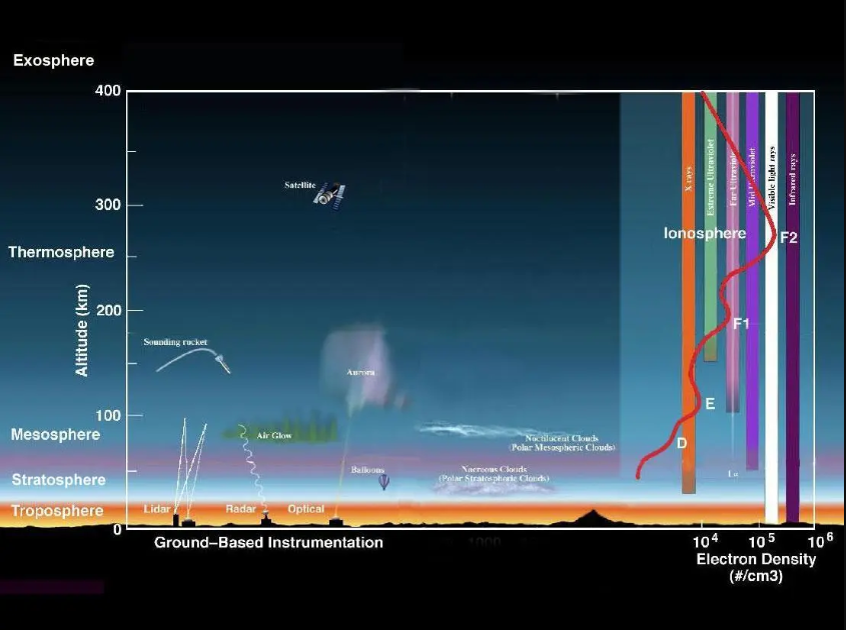The atmosphere is a crucial element of Earth’s interconnected physical systems. It consists of layers of gasses that envelop the planet and other celestial bodies. This article aims to provide a comprehensive overview of the Earth’s Atmosphere and its Compositions & Structure.
Composition of the Earth’s Atmosphere
- Earth’s atmosphere is primarily composed of nitrogen (78%), oxygen (21%), and other gasses (1%). These gasses are distributed across different atmospheric layers, namely the troposphere, stratosphere, mesosphere, thermosphere, and exosphere.
- There are three stages in the evolution of the present atmosphere. The first stage is marked by the loss of primordial atmosphere. In the second stage, the hot interior of the earth contributed to the evolution of the atmosphere. Finally, the composition of the atmosphere was modified by the living world through the process of photosynthesis.
Read our detailed article on Interior of the Earth: Sources & Compositions
- Each layer has distinct characteristics such as temperature and pressure. It acts as a shield against harmful ultraviolet (UV) radiation, provides insulation to keep the planet warm and regulates temperature variations between day and night.
- The sun’s heat causes the atmosphere to convect, driving air movement and influencing weather patterns worldwide.
- The atmosphere is made up of gasses, water vapour, and dust particles. As we move higher up in the atmosphere, the proportion of gasses changes. At around 120 km in height, the amount of oxygen becomes extremely small and almost negligible.
- Similarly, carbon dioxide and water vapour are only present up to a distance of 90 km from the Earth’s surface.
- The below table shows the details of different gases in the air in the lower atmosphere-
| Gases | Carbon dioxide plays a crucial role in the atmosphere. It is transparent to incoming solar radiation, but it becomes opaque to outgoing terrestrial radiation. This means that it absorbs some of the Earth’s radiation and reflects a portion of it back towards the Earth’s surface. As a result, carbon dioxide contributes significantly to the greenhouse effect. Ozone is found between 10-50 km in the stratosphere. It acts as a protective filter, absorbing the harmful ultraviolet rays emitted by the sun and preventing them from reaching the Earth’s surface. |
| Water Vapour | It is a gas in the atmosphere that varies in amount depending on altitude. In tropical regions with warm and humid climates, it can make up about four percent of the air by volume. However, in dry and cold areas like deserts and polar regions, it may be less than one percent of the air. The concentration of water vapour also decreases as you move from the equator towards the poles. It absorbs the sun’s energy and retains the Earth’s radiated heat which helps to regulate the temperature and prevent it from becoming too hot or too cold. Additionally, water vapour influences the stability and instability of the air. |
| Dust Particles | Atmosphere keeps small solid particles, which originate from different sources which include sea salts, fine soil etc. They are generally concentrated in the lower layers of the atmosphere and transport by convection air currents to great heights. The higher concentration of it is found in subtropical and temperate regions due to dry winds in comparison to equatorial and polar regions. |
Structure of the Earth’s Atmosphere
- The Earth’s atmosphere is composed of several layers that have different densities and temperatures. The density is highest near the Earth’s surface and decreases as you go higher.
- The atmosphere is divided into five layers based on temperature: troposphere, stratosphere, mesosphere, thermosphere and exosphere.

| Troposphere | The area where the troposphere and stratosphere intersect is called the tropopause. The temperature at the tropopause in Earth’s atmosphere is around -80°C near the equator and -45°C near the poles. The tropopause is distinguished by its consistent temperature. Beyond the tropopause is the stratosphere, which extends to an altitude of 50 km. One significant characteristic of the stratosphere is the existence of the ozone layer. This layer absorbs ultraviolet radiation and safeguards life on Earth from harmful and powerful energy. |
| Stratosphere | Exosphere is the topmost layer above the thermosphere. There is limited information about it. The exosphere contains very few particles, and it gradually blends with outer space. However, all layers of the earth’s atmosphere have exercising influence on us. The geographers are widely concerned with the first 2 layers of the atmosphere. |
| Mesosphere | The layer above the stratosphere is known as the mesosphere, a part of Earth’s atmosphere. It extends up to 80 km in elevation. In this layer, the temperature decreases as the altitude increases, reaching as low as minus 100° C at the 80 km point. The mesopause is the upper boundary of the mesosphere. Beyond the mesopause, between 80 and 400 km, lies the ionosphere or thermosphere. This region consists of ions, which are charged particles.The ionosphere is accountable for reflecting radio waves back to Earth. Interestingly, the temperature in this layer begins to rise as altitude increases. |
| Thermosphere | The thermosphere is a layer found in Earth’s atmosphere, situated above the mesosphere and below the exosphere. It spans a height ranging from approximately 90 km to between 500 and 1,000 km above the Earth’s surface. The thermopause, which is the boundary separating the thermosphere and the exosphere, lies above it. Within the lower thermosphere, temperatures rise steeply before stabilizing and remaining relatively constant as altitude increases. Solar activity greatly influences the temperature in the thermosphere. |
| Exosphere | The exosphere is the topmost layer above the thermosphere. There is limited information about it. The exosphere contains very few particles, and it gradually blends with outer space. However, all layers of the earth’s atmosphere have exercising influence on us. The geographers are widely concerned with the first 2 layers of the atmosphere. |
To sum up it can be said that the elements of weather and climates include, namely temperature, pressure, winds, humidity, clouds, and precipitation, are dynamic in nature and have a significant impact on earth’s atmosphere and human existence on our planet.
Source:









